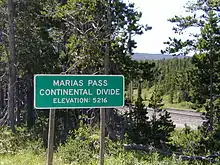Marias Pass
Marias Pass (elevation 5,213 feet (1,589 m)) is a high mountain pass in the western United States near Glacier National Park in northwestern Montana.
| Marias Pass | |
|---|---|
 Marias Pass obelisk and statue of John F. Stevens. | |
| Elevation | 5,213 ft (1,589 m) |
| Traversed by | |
| Location | Glacier County, Montana, U.S. |
| Range | Lewis Range |
| Coordinates | 48.3183°N 113.3552°W |
 Marias Pass  Marias Pass | |
The pass traverses the Continental Divide in the Lewis Range, along the boundary between the Lewis and Clark National Forest and the Flathead National Forest. The pass forms the southern limit of the Continental Ranges, a major grouping of the Rocky Mountains which extends as far north as McGregor Pass in the Northern Rockies of the Canadian province of British Columbia. The Great Bear Wilderness in Lewis and Clark National Forest is south of the pass and Glacier National Park is to the north.
During the winter, the pass is the only way to cross the Continental Divide by road in the U.S. north of Montana's Rogers Pass (distinguished from British Columbia's Rogers Pass), because of the Bob Marshall Wilderness Complex.
History
The pass was charted in December 1889 by John Frank Stevens, principal engineer of the Great Northern Railway (GN).[1] The location of the pass had been rumored for several years beforehand, but it took Stevens and a Flathead guide named Coonsah, who had been hiding out with the Blackfoot in Browning, to discover it.
The pass proved ideal for a railroad, because its approach was broad and open, within a valley ranging from one to six miles wide, and at a gentle grade that would not require extensive excavation or rockwork. Construction of the railroad through the pass began on August 1, 1890, starting from Fort Assinniboine toward Marias Pass. The railroad followed the Middle Fork of the Flathead River west of the Continental Divide.[2]
Stevens also discovered the pass across the Cascades in central Washington which bears his name.
Roosevelt Memorial Obelisk
A memorial to President Theodore Roosevelt was constructed along the Continental Divide at the top of the pass. Construction began in 1930, with the original intent to produce a granite archway across the highway, and a cornerstone was placed to the southeast of the highway. Eleanor Roosevelt was later on hand to place a small copper box filled with a copy of the bill that appropriated funds for the memorial as well as some other documents into the cornerstone. The obelisk is sixty feet (18 m) in height and extends nineteen feet (5.8 m) into the ground. It has a tapering cement core covered on all sides with seven-inch (18 cm) slabs of Montana granite quarried near Helena. It was later decided to build an obelisk instead of an archway; it was completed 90 years ago in 1931.[3]
Today, U.S. Route 2 uses the pass, along with the BNSF Railway, a successor to the Great Northern Railway. The railway line, which sees freight traffic, as well as Amtrak's Empire Builder, is part of BNSF's Northern Transcon line linking Chicago and the Pacific Northwest. A statue of Stevens stands at the summit of Marias Pass.[1]
 Marias Pass highway marker along US Route 2
Marias Pass highway marker along US Route 2.jpg.webp) An eastbound BNSF intermodal train cresting the summit of the pass
An eastbound BNSF intermodal train cresting the summit of the pass
See also
- Mountain passes in Montana
References
- "G.N. to erect Stevens statue". Spokesman-Review. (Spokane, Washington). June 30, 1925. p. 5.
- Guthrie, C.W., (2004), All Aboard for Glacier, Farcountry Press: Helena, MT, 1-56037-276-1
- "Roosevelt Memorial Obelisk".